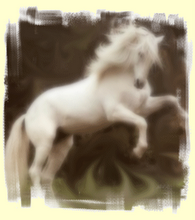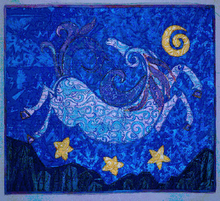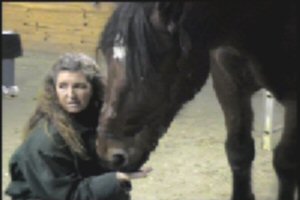QUESTION: How do you determine the difference between a fear reaction and a wary display?
ANSWER: This is fairly easy to tell. The overall body language and the mental/emotional state will reveal a lot. A fear reaction is going to elicit a white-eyed panic response to instant, getting-out-of-town response without regard for surrounding environment. A horse that is in a panicked state will be thinking of just ONE thing and that's SURVIVAL .. To stay alive. That horse/pony is going to back up and try to RUN and run FAST! A wary response may bring on a white eyed response but less panicky movements and response. Both instances will present with a "head up" response as horses react physiologically from that position. In other words, head up equals alert/flight/survival and instantly sets off the adrenalin needed to run. Head down equals relaxation and content/comfort/calm and stops the adrenalin flow. Take, for instance, the horse that has been "punished" with extreme pressure to the front end (for example, in response to a bite many people will punch the horse with a very angry, forward reaction to the bite or nip. NOT the response that is going to teach the pony that biting is not acceptable. A more appropriate response would be to make yourself as big as possible in body and mind and strongly "banish" or chase the pony/horse off or quickly and firmly cause him to move his feet ... Fast and furiously!) ... A human who aggressively goes after the pony will scare the pants off the critter! If repeated many times, the pony is going to begin to present with the extreme flight/fear response of white-eyed panic all the time and it will take awhile for that pony to trust humans again. Any pony or horse that has met with extreme aggression from humans is going to respond with a fear response.
A "wary" response is a horse/pony that is going to respond to the human with an alert, Yes, Ma'am! Or Yes, Sir! Attitude. There may be a little bit of white showing in the eye but the body language is not going to be as dramatic as a fear-based response. The horse/pony may turn head away from the handler or move body away but its just not going to be an extreme movement. The behavior is offered with an attitude of caution from the horse or pony but not down and out fright.
Sometimes we WANT an instant, extreme movement from the horse and its OK to be a bit more ASSERTIVE than usual but unless one feels he/she is in imminent danger of losing one's life then the aggressiveness should be packed away in the netherlands somewhere when working with horses and ponies. Notice, please, I used the word "assertive" and not "aggressive". Both words are expressions of the state of mind of the presenter/handler ... Aggression is always born of fear and anger/frustration whereas assertiveness is a state of leadership, confidence, comfort, strength and nuturing all at the same time. ASSERTIVE is the attitude we, as human leaders for our horses and ponies, should always exude when teaching or correcting.
Equine sense our ATTITUDES more than our voices or even our body language. Our attittudes exude energy as our cells change in our thinking, feeling, etc. The horse/pony is designed to FEEL and respond to those attitudes with exactness. They "read" or discern their environment as part of their innate survival system.
Something else to remember, too, is that horses and ponies will reprimand/correct each other within an instant of the offending behavior and the correction lasts for just a few seconds then all return to their normal routine of grazing or whatever. They do not REPEATEDLY go after one another for extended periods of time and certainly not 5 or 10 mins. or even a minute after the offensive behavior. They correct INSTANTLY.
With this knowledge in hand, now, it would be recommended that we all check our attitudes when around our horses and ponies. A confident, strong, compassionate LEADER is going to help the horse become a brave, confident, willing partner or companion. A mean-spirited, angry, frustrated, fearful handler attitude is going to create a nervous, fearful equine; one that wants nothing to do with humans.
QUESTION: What are the obvious differences to observe between a healthy trusting relationship and a relationship based from fear?
ANSWER: A healthy, trusting relationship between horse and human is one where it is obvious that the horse/pony WANTS to be with his human! A horse that willingly comes when called with excitement and eagerness tells me that the horse is excited that his human is nearby and wants to be with him. The horse will choose to stay with the human when not restrained and will stick by the human, even when grazing in the paddocks with other horses. The horse responds favorably to requests from the human without any signs of fear or intrepidation (tense body, ears back, tail stiff or switching, whites of eyes displayed, nostrils flared, mouth tense ... Horse ready for flight at any moment). A trusting horse may nicker or whinney at the sound of his human's voice or presence in familiar "greetings". A general air/attitude of excitement, contentment and peace will pervade the horse's being.
A relationship based on fear will be exhibited with the horse/pony's obvious stiffness in body and displeasure at being haltered, groomed, handled or even ... "caught". Obvious mistrust is evident in the horse's or pony's attitude. The horse will constantly turn its head away from the human or lean away; even try to "get away".
It is important, also, to be able to distinguish a horse or pony that has "checked out" mentally from a horse that is alert and right there at the "scene" mentally. A horse that has had repeated unfavorable situations with humans or one that has been forced to "submit" to humans will check out mentally just as a survival mechanism. When "flooding", a method of training horses and ponies to accept foreign objects or situations (ie. Bathing with water) is utilized the horse or pony may initially run away from the offending object but then all of a sudden stop running and stand frozen in its place. Eyes frozen wide open, nostrils flaring and respirations highly increased, whole body is tense - This is a blatant example of a horse checking out. Giving up its flight instinct to survive. The horse may then become "obedient" to the handler but the mind of the horse is not all there. It is like he's operating on remote. This is a dangerous place to be ... For both the horse and the handler. The trusting horse is going to be able to be encouraged to explore a foreign object or situation in its own time, being allowed to move its feet away if needed and when needed, but will exhibit curiosity and increasing relaxation with the final outcome being that the horse becomes 100% OK with whatever the situation is and is relaxed and "thinking" about it. A blinking horse is a thinking horse. Or, a thinking horse is a blinking horse.
Horses and ponies are naturally curious and the more time we spend in encouraging them to explore their environments and to be able to feel safe with us, their human partners, the stronger and more pleasureable the relationship between the horse and human will be. When we think and act in terms of TEACHING our ponies rather than training them then we will begin to set down a relationship that is based on TRUST and mutual RESPECT. This type of relationship can only flourish with time.
Subscribe to:
Post Comments (Atom)



1 comment:
"A trusting horse may nicker or whinney at the sound of his human's voice or presence in familiar "greetings"."
How very true Gwen, ...and how honored I always feel when the arrival of our car is greeted by screams and whinnies of greeting, ..and the fact that they do come, at least every time they hear us arrive, which they do as long as the wind is not in the wrong direction, is at least proof that we are doing *something* right, whatever mistakes we may be making otherwise!
Post a Comment